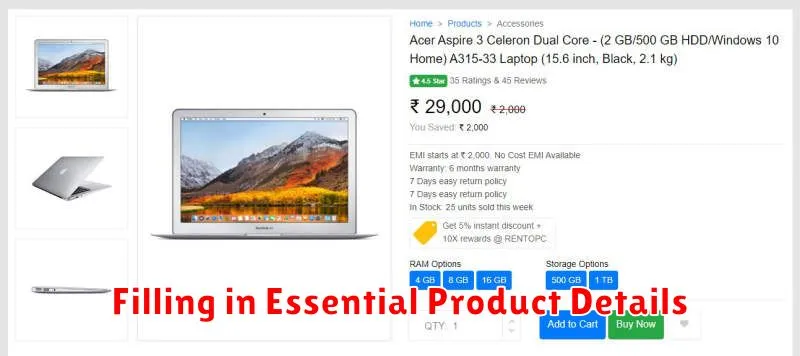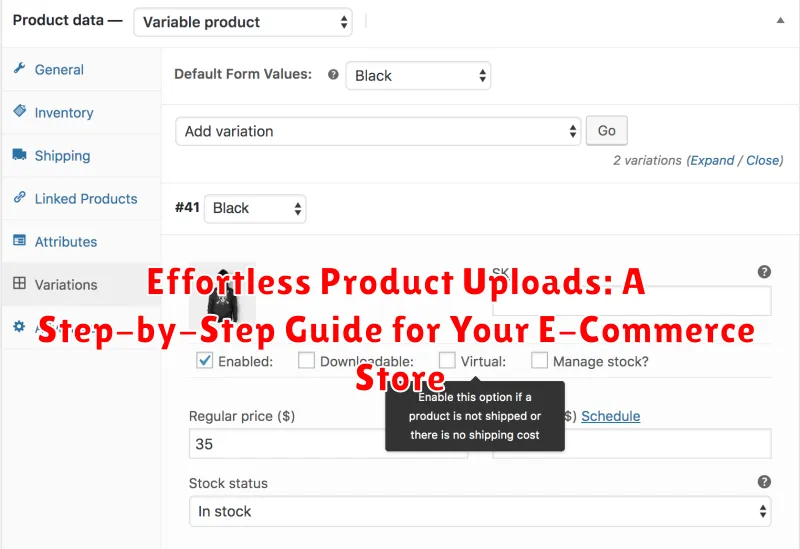In today’s competitive e-commerce landscape, efficient product uploads are crucial for success. A streamlined and effortless product upload process can significantly impact your online store’s performance, allowing you to quickly showcase new items, manage inventory effectively, and ultimately, drive sales. This step-by-step guide will provide you with the knowledge and tools to optimize your product uploads, ensuring a seamless experience for both you and your customers. Whether you’re just starting your e-commerce store or looking to improve your current workflow, this comprehensive guide will empower you to take control of your product listings with ease. Learn how to minimize manual data entry, avoid common pitfalls, and create compelling product pages that convert.
This guide focuses on creating effortless product uploads for your e-commerce store. We’ll cover essential aspects of product listing optimization, from preparing your product data to utilizing bulk upload features and leveraging best practices for product descriptions and images. By following these step-by-step instructions, you can transform your product upload process from a tedious chore into a streamlined operation, freeing up valuable time and resources to focus on other critical aspects of growing your business. Join us as we explore the key strategies to achieve effortless product uploads and unlock the full potential of your online store.
Organizing Your Product Information
Before you begin uploading products to your e-commerce store, taking the time to organize your product information is crucial. This preparation will streamline the upload process and ensure consistency across your product listings.
Start by creating a spreadsheet or using a product information management (PIM) system. This will serve as your central hub for all product-related data. Key information to include for each product is:
- Product Name/Title: Use a clear and concise name that accurately reflects the product.
- Description: Write a compelling and informative description highlighting key features and benefits.
- SKU (Stock Keeping Unit): Assign a unique identifier to each product variation.
- Categories and Tags: Categorize your products for easy navigation and searchability on your website.
- Pricing and Inventory: Track your costs, selling price, and available stock.
- Product Specifications: List technical details, dimensions, materials, and other relevant attributes.
Having this information readily available in an organized format will greatly simplify the upload process and reduce the risk of errors.
Accessing Your E-Commerce Platform’s Product Management Section
The process of accessing your product management area varies slightly depending on your chosen e-commerce platform. However, the general principles remain consistent. This section will outline common methods for locating this crucial section of your store’s administrative backend.
First, log in to your e-commerce platform’s administrator dashboard. This typically involves entering your registered email address and password on a designated login page.
Once logged in, look for a menu or navigation bar. Common labels for product management sections include “Products,” “Inventory,” “Catalog,” or similar terms. These menu items are often located prominently within the main navigation or sidebar.
Some platforms use a dashboard-style interface. In these cases, look for a widget or panel specifically dedicated to product management. This may be labeled with an icon related to products or inventory.
If you are unable to locate the product management section, consult your e-commerce platform’s documentation or support resources. They will provide platform-specific instructions and guidance.
Filling in Essential Product Details

This stage focuses on providing comprehensive information about your product. Accuracy and detail are crucial for both customer satisfaction and search engine optimization.
Product Title
Create a concise and descriptive title that accurately reflects the product. Use relevant keywords to improve search visibility. Avoid unnecessary jargon or overly promotional language.
Product Description
Write a detailed description highlighting the product’s features, benefits, and specifications. Address key customer questions and concerns. Use clear and concise language, breaking down information into digestible paragraphs or bullet points.
SKU and Other Identifiers
Assign a unique SKU (Stock Keeping Unit) to each product. If applicable, include other identifying information such as UPC, EAN, or ISBN. These identifiers are essential for inventory management and order fulfillment.
Adding High-Quality Product Images

High-quality images are crucial for showcasing your products and enticing customers. Aim for clear, well-lit photos that accurately represent the item’s color, texture, and size.
Use a neutral background to minimize distractions and ensure the product is the focal point. A white or light gray backdrop is generally recommended.
Showcase the product from multiple angles. Include close-ups to highlight details and textures. Consider lifestyle shots to demonstrate the product in use, if applicable.
Optimize your images for web use. Large file sizes can slow down your website’s loading speed. Resize images appropriately and use a compressed file format like JPEG or PNG.
Maintain consistent image sizes and styling across all your product listings for a professional and cohesive look.
Setting Prices and Inventory
Accurate pricing and inventory management are crucial for a successful e-commerce business. This section outlines how to input these vital details for your products.
Setting Prices: Input the selling price for each product. Consider factors such as cost of goods, profit margins, and competitor pricing. You may also want to include fields for sale prices or promotional pricing, if applicable to your platform. Ensure clear display of currency to avoid confusion.
Managing Inventory: Input the quantity of each product currently in stock. This allows your platform to track availability and prevent overselling. Set up low stock alerts to notify you when it’s time to reorder. If you offer different product variations (e.g., sizes or colors), manage inventory for each variation separately.
SKU Management: Assign a unique Stock Keeping Unit (SKU) to each product. This helps with inventory tracking and internal organization. If your products don’t already have SKUs, create a system that works for your business.
Optimizing Product Descriptions for Search Engines
Product descriptions are crucial not only for informing customers but also for search engine optimization (SEO). Well-optimized descriptions help search engines understand what your products are, leading to higher rankings in search results and increased visibility.
Start by incorporating relevant keywords. Research which terms customers use when searching for similar products. Naturally weave these keywords into your descriptions, avoiding keyword stuffing.
Focus on providing unique content for each product. Duplicate descriptions can negatively impact SEO. Highlight the unique selling propositions of each item.
Structure your descriptions with headings and bullet points to improve readability. This makes it easier for both customers and search engines to digest the information.
Pay attention to description length. While there’s no magic number, aim for descriptions that are comprehensive yet concise. Provide enough detail to inform purchasing decisions without overwhelming the reader.
Previewing and Publishing Your Products
Before making your products live, thoroughly preview them to ensure accuracy and a polished presentation. Most e-commerce platforms offer a preview function, allowing you to see exactly how your product listing will appear to customers.
Pay close attention to the following during your preview:
- Product Title and Description: Verify for clarity, accuracy, and proper formatting.
- Pricing and Variations: Ensure accurate pricing is displayed for all product options.
- Images: Confirm image quality, proper sizing, and appropriate representation of the product.
Once satisfied, proceed to publish your product. This typically involves a simple click of a button or selecting a publishing option within your platform’s interface. Upon publishing, your product becomes visible to shoppers on your online store. Some platforms offer scheduling options, enabling you to set a specific date and time for your product to go live.
Managing Product Variations and Options
Effectively managing product variations is crucial for a smooth customer experience. This involves organizing different versions of a single product, such as color, size, or material. A well-structured system simplifies both the upload process and the customer’s selection process.
Most e-commerce platforms provide tools specifically designed for variation management. These tools often involve creating a parent product and then defining the different attributes that create variations. For example, a t-shirt (parent product) might have attributes for size (small, medium, large) and color (red, blue, green).
Inventory tracking for each variation is essential. This ensures accurate stock information is displayed to customers, preventing overselling. Some platforms automatically manage inventory across variations, while others may require manual adjustments.
Consider using a SKU (Stock Keeping Unit) system for each variation. This provides a unique identifier for each specific product version, simplifying inventory control and order fulfillment. Clear SKUs are also beneficial for internal tracking and reporting.

